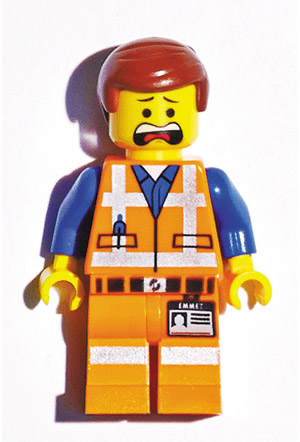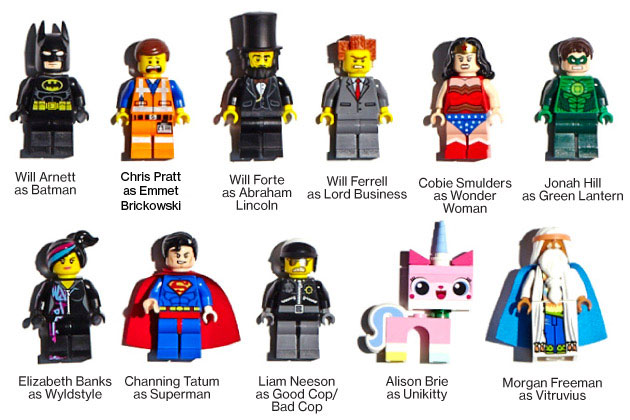
LEGO GOES TO HOLLYWOOD
By Felix Gillette February 05, 2014 Kissing was a point of contention. “We had some kissing in the movie,” says Dan Lin, the producer of The Lego Movie. “It wasn’t lusty. When two minifigs kiss, there’s no tongue or anything. It’s just plastic kissing plastic, which we just thought was hilarious.”
Kissing was a point of contention. “We had some kissing in the movie,” says Dan Lin, the producer of The Lego Movie. “It wasn’t lusty. When two minifigs kiss, there’s no tongue or anything. It’s just plastic kissing plastic, which we just thought was hilarious.”
The Lego brand managers were less amused. “They warned us that parents don’t like it when minifigs kiss,” says Lin. “We tested the movie several times. They were right. Parents didn’t like it.” In the end (spoiler alert), the kisses got cut. Instead, there are several romantic moments in the movie, featuring close-ups of amorous minifigures attempting to lock together their fingerless, cup-shaped hands. The effect is equally absurd.
On Feb. 7, The Lego Movie, a feature-length animated film and the first theatrical release based on the ubiquitous toy, will open around the country. It’s voiced by an ensemble cast of comedic actors (Will Arnett, Elizabeth Banks, Chris Pratt), Hollywood dignitaries (Morgan Freeman, Liam Neeson), and American celebrities at large (Shaquille O’Neal).
Produced by Lin, co-financed by Village Roadshow (VRL:AU), and distributed by Warner Bros. (TWX), The Lego Movie took more than five years to make. It’s directed by Chris Miller and Phil Lord, whose credits include the animated hit Cloudy With a Chance of Meatballs. The Hollywood Reporter estimates it cost $60 million to $65 million to make.
Photographs by Jeff Brown for Bloomberg BusinessweekSince the 2007 release of Transformers, when Paramount Pictures (VIAB) created a multibillion-dollar entertainment franchise out of a moribund toy line, Hollywood has been awash in toy-inspired media. From the outset, the filmmakers’ goal was to create a Lego-infused movie that would amount to something more interesting than a 100-minute advertisement.
 “A lot of people might think, ‘OK, this is all about them trying to sell the most toys,’” says Jill Wilfert, Lego vice president for global licensing and entertainment. “For us, this was always about building the Lego brand.” Which, of course, is about selling toys, and an avalanche will accompany the film’s release, including 17 Lego building sets, a line of collectible minifigures, a video game, a theme park exhibit, a soundtrack album, children’s books, and tons of lunchboxes, sticker books, T-shirts, hoodies, pajamas, backpacks, and Lego-branded undergarments.
“A lot of people might think, ‘OK, this is all about them trying to sell the most toys,’” says Jill Wilfert, Lego vice president for global licensing and entertainment. “For us, this was always about building the Lego brand.” Which, of course, is about selling toys, and an avalanche will accompany the film’s release, including 17 Lego building sets, a line of collectible minifigures, a video game, a theme park exhibit, a soundtrack album, children’s books, and tons of lunchboxes, sticker books, T-shirts, hoodies, pajamas, backpacks, and Lego-branded undergarments.
At a time when Hollywood filmmakers are increasingly reliant on money from overseas audiences for survival, a movie based on a toy with such broad, cross-cultural appeal would seem like a no-brainer. “I can’t tell you how many people come up to me now and say, ‘Oh, a Lego movie? No duh. It’s so obvious,’” says Lin, whose job it was to persuade Lego to seize this opportunity. “It was absolutely not obvious five years ago.”
These days the 80-year-old company is flying high. In 2012, Lego generated a $969 million profit on revenue of $4 billion and, buoyed by a 24 percent increase in sales, passed Hasbro (HAS) to become the second-largest toymaker in the world. It’s a big turnaround from 2003-04, when an ill-fated period of product experimentation resulted in big losses. The key lesson the company took away from its dark years: Focus on toys, proceed cautiously when experimenting, and find good partners. In previous forays outside the toy business, the privately held company tried to do it all by itself and frequently stumbled.
Earning Lego’s confidence, says Lin, was the biggest challenge. “My big pitch to them was, ‘This is a way for you to get into the storytelling universe,’” says Lin, 40, a former Warner Bros. executive whose eponymous production company has a first-look deal with the studio. “It’s up to us to meet your motto that ‘Only the best is good enough.’ If we tell a great story, it can have a halo effect for your brand.”
Lin’s ambitions for The Lego Movie went beyond simply enhancing the company’s reputation. “What I’ve told Warner Bros.,” says Lin, “is that if this movie works, in the future you’ll have live-action movies, you’ll have animated movies, and you’ll have Lego movies. It will be a new class of films that look photo real, that are very funny, and have a very specific tone. It’s a look you’ve never seen before.”
On the way to the première, there was plenty of friction between toymaker and filmmaker. “I’m not saying it was an easy five years,” says Lin. “There was a lot of great creative push and pull. We made different versions of this movie three times. The biggest thing was, how edgy can the movie be?”
Wilfert, 48, speaks in measured sentences and emits a calm vibe, absent the manic elation that typifies Hollywood salesmen. She says that since joining Lego a quarter century ago she’s traveled to the company’s headquarters in Billund, Denmark, so many times she “practically feels like a Dane.” From her home base in Carlsbad, Calif. (home also to one of the company’s licensed Legoland theme parks), she serves as liaison to the movie, TV, and video game industries. She buys entertainment licenses for Lego to turn into toy lines, and she sells Lego licenses for others to turn into entertainment. Wilfert’s job is not only to make sure Hollywood storytellers are happily playing with Lego but also to ensure they’re playing well and in an un-profane manner.
_White.png)